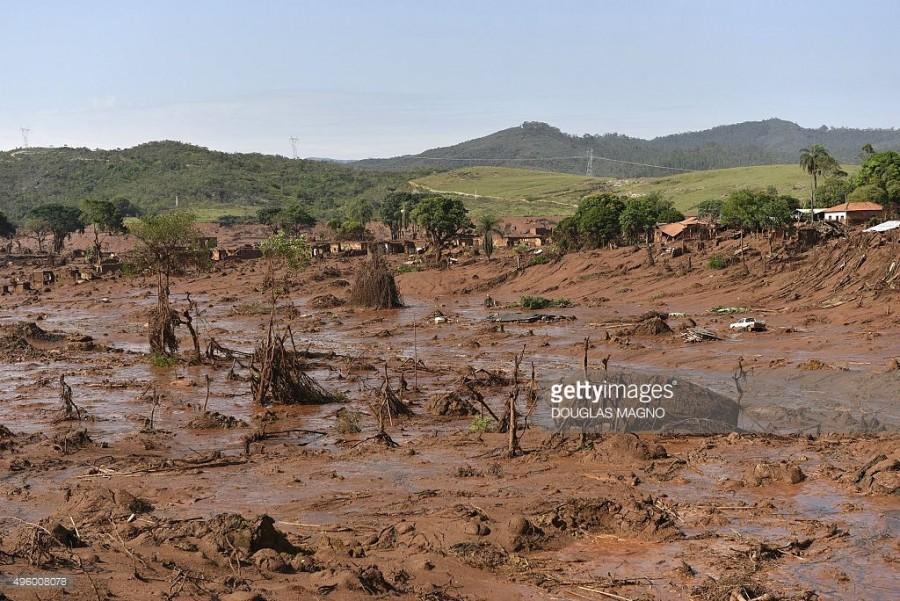Disaster in Mariana, MG: the Rupture of the Samarco Dams
On Thursday, 5 November 2015, Brazil was shaken with news about the rupture of the dams in Minas Gerais. According to reports, the two Samarco dams of Fundão and of Santarém collapsed at around 3:30 p.m. The dams, co-owned by Brazilian mining company Vale and Anglo-Australian company BHP Billiton, unleashed about sixty million cubic meters of sludge containing toxic mining waste onto the surrounding region. The massive waves of sludge struck locations including Bento Rodrigues, Águas Claras, Pedras, Paracatu, Ponte Gama, and Barra Longa. Bento Rodrigues, a district of Mariana, was reportedly the most heavily affected, resulting in hundreds of victims losing their homes and property. Several people were reported missing or even killed.
In order to locate and rescue the victims, backhoe loaders were used to excavate a passageway amidst the mud, and rescue teams used three helicopters as assistance to overfly the flooded area. On 5 November 2015 the Corpo de Bombeiros e Defesa Civil announced that the firefighters had rescued more than five hundred people from Bento Rodrigues. These rescued civilians then went through a process of “decontamination to avoid any potential damage caused by the iron,”of which the first step was immediately being washed with water and soap. All the victims were taken to the hospital for examinations and treatments. It was confirmed in December 2015 that seventeen people were killed and two were still missing. The identified victims who were killed in the incident include children, workers, and residents of Mariana.
As Bento Rodrigues was taken aback by the flood of sludge, most of the area was completely destroyed. Inhabitants were forced to flee to the upper parts of the district, but many have affirmed that no adequate warning signal or alerts were issued. “Samarco admitted that it only warned inhabitants through telecommunication,” despite the list of contacts used by the company being allegedly outdated. Also, sources with access to Samarco’s Emergency Plan claim that the plan recognizes the importance of warning the population, though it does not specify how it would alert the people during an emergency.
Moreover, the sludge reached Rio Doce, which is one of Brazil’s most important rivers, and took a great number of lives (including animals such as fish) that depended on the river. The now contaminated waters were deemed dead by several environmental specialists. They informed it would take approximately 100 years for the Rio Doce to regain a somewhat similar composition to its original state due to the “25,000 Olympic swimming pools of mud” that polluted the river. Paul Rosman, Professor of Coastal Engineering at COPPE / UFRJ, claimed that “the rain itself [would] clean out the mud and the fish [would] return to the river in about five months, and at sea, the dilution of sediments will occur faster.”
Brazilian President Dilma Rousseff announced on 6 November 2015 that affected victims were permitted to withdraw up to R$6200 from the FGTS (Fundo de Garantia do Tempo de Serviço) for “immediate expenses.” In addition, a huge influx of donations were received coming from all over Brazil. The Prefeitura de Mariana released a statement that thanked the nation’s solidarity, though it also informed that it would temporarily suspend the donations twenty days after the disaster “to survey the amount of items donated to date, in order to ascertain whether they meet the needs of the population affected by the disaster in Bento Rodrigues.” It also noted that “[their] main concern is to avoid the waste of supplies already donated.”
As to the leading cause, it is still unclear what provoked the rupture of the Samarco dams. The operating license of the Santarém Dam had reportedly expired in 2013, whereas the Fundão Dam has a valid license until 2019. However, according to the Secretaria do Meio Ambiente de Minas Gerais, this is not an issue as the mining company had applied for a renewal of its licenses before the expiration dates, which is required by the legislation, and it could apparently continue its operations until it was given information about its license. Moreover, Samarco informed that it registered “two small tremors in the area” two hours prior to the collision. Sources claim that the risk of the dams bursting was already known by the company as “the contact between the pile of wastes and the dam is not recommended due to the risk of destabilization of the cell mass and enhancement of erosion.” Additionally, Joaquim Pimenta de Ávila, the engineer who designed the dams, stated that he had warned Samarco one year prior to the rupture about the risk. He also told authorities that there was in fact more mud in the dams than Samarco had previously reported.
The company has been charged with several fines, including one that demands it to deposit a quantity of about R$2 billion. According to sources, such as Folha de SP and G1, on 18 December 2015, the Advocacia-Geral da União ordered Samarco, Vale and BHP Billiton to make a judicial deposit of R$2 billion due to environmental damage. The AGU also stated that if the company failed to meet its deadline, it would have to pay a fine of R$1.5 million (per day).
Sources: g1.globo.com, noticias.uol.com.br, bbc.com/news, veja.com, folha.uol.com.br








